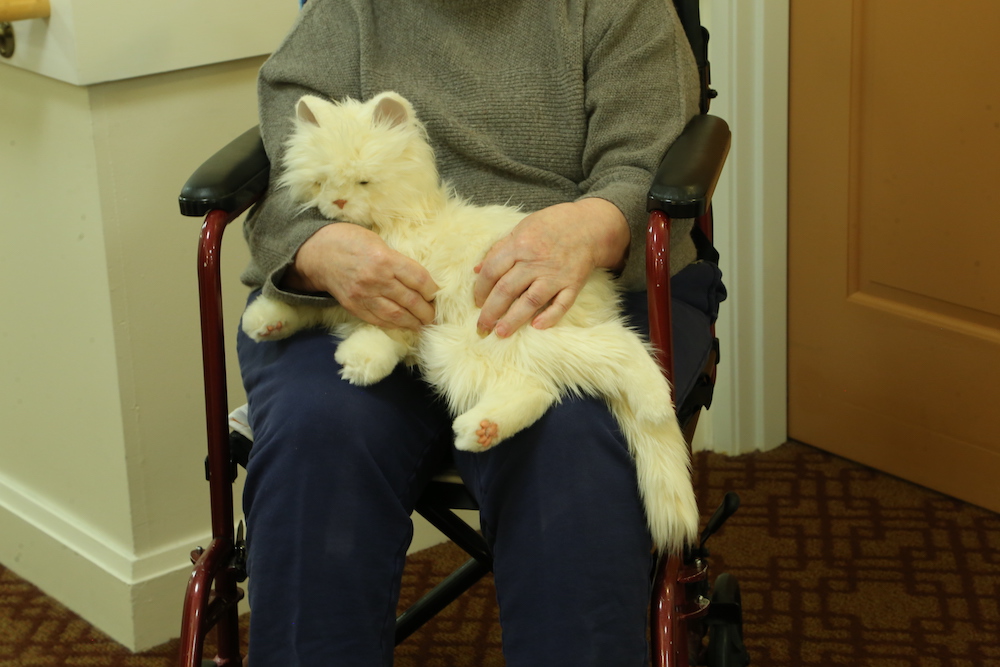By: Emma Davis | Posted: June 24, 2021 | Updated: May 11, 2023
Caption: Memory Care Unit Robotic Pet Menagerie
Wondering if “Robotic Pets for Seniors” are a good idea?
Here is a real world report of the author’s experience deploying robotic pets for dementia patients in an assisted living and memory care facility in San Francisco (Rhoda Goldman Plaza).
Read on to learn how they were used, what the reactions were to the robot stuffed animals, and what some of the “issues” were to make sure they were a benefit to the patients.
Disclaimer: Neither the author nor the author’s organization were compensated by vendors of robotic pets for doing this work, or for deploying the pets at the author’s organization.
What is a Robotic Pet?
Robotic pets are toy animals that have life like qualities including sound and movement. Most robotic animals are powered by batteries and have sensors that respond to movement and touch. The animatronic animals blink, move the head and mouth, and produce life like sounds. By use of the on/mute/off button, the user can adjust the level of response.
Play the short video below to watch how the animals move and sound.
Robotic animals are not a replacement for living, breathing animals but they are an effective alternative for seniors and individuals with memory impairment when live animals are not available or no longer safe.
The uses and benefits of robotic animals has become even more apparent during the restrictions that so many individuals have experienced during the recent pandemic. Furthermore, robotic animals can be used in conjunction with live animals or virtual animal experiences to enhance the therapeutic experience.
Animal Therapy Meets Robot Stuffed Animals
We have all heard the saying: “A man’s best friend is his dog.”
I know from both personal experience and scientific studies the benefits of animal therapy.
I am the daughter of a veterinarian and grew up with many animals throughout my life. It is hard to imagine my life without animals. Yet, I know there may come a time in my life when I am unable to care for an animal in a safe and healthy way as is the case for many of the individuals I work with.
Animals provide an unconditional love and the loss or absence of it can be devastating.
Now imagine, you not only have lost this animal that means so much to you but your brain is unable to retain the reason why the animal is no longer with you. All you remember is the loss.
This is the experience for many individuals with dementia.
Animal Therapy Helps. Not Always Realistic.
You don’t have to just have to take my word regarding the value animals provide to the human experience.
A study conducted by the American Heart Association’s Scientific Sessions showed that animal assisted therapy (AAT) was shown to have “helped heart and lung function by lowering pressures, diminishing release of harmful hormones and decreasing anxiety among hospitalized heart failure patients” (Ref. 1). The study showed that spending just twelve minutes with a dog produced health benefits. Furthermore, a study conducted by Nancy Richeson regarding the use of ATT with older adults with dementia “showed statistically significant decreases in agitated behaviors and a statistically significant increase in social interaction”. (Ref. 2)
Is it practical and possible to provide AAT visits on a regular basis? Not always. Thus, the challenge becomes is there a way to replicate the benefits of AAT that is readily available and easily accessible? It was in the quest to answer this question that I found robotic animals.
What We Did
I was feeling frustrated with the limited availability of live animals to the residents I work with and I turned to the internet.
First, I found several stuffed animals marketed as realistic and life-like. The reactions to these animals was overwhelmingly negative, with one individual going so far as to believe that the stuffed animal was taxidermy.
Next, I tried the Joy for All Companion Pets.
I convinced my supervisor at the time that we should invest the $100 to try this with our residents. It turned out to be an investment that was well worth the return.
Our memory care unit now has a community collection of six robotic cats and one robotic dog.
Yet, the only robotic animal actually purchased with Rhoda Goldman funds was that very first one. The growing collection is result of donations from the families of residents’ who purchased one for their loved one and donated the animal upon the death of their loved one. In fact, many resident families purchased personal robotic pets after observing the reactions to the community robotic pet(s).
Our robotic pets ‘live’ in our communal spaces. They adorn the shelves, chairs, and counters when not in use. Often they will end up in a resident’s room but eventually they return to the community space. My goal is to make them available for use when needed by any resident or staff member.

Caption: Robotic Pets “Live” in the communal space
Not a “Replacement” for a Live Animal
I would like to be clear that a robotic pet is not a replacement for a live animal.
Robotic animals cannot adapt their response to you in the way a real animal can. At least, not yet! However, a robotic animal can provide a level of stimulation, engagement and comfort that one cannot find with a simple stuffed animal. I hope to illustrate the uses and benefits of robotic animals by sharing some of the real reactions I have observed in my work with our residents.
The majority of reactions to the robotic pets are positive. Initial responses usually include:
- verbally addressing the robot stuffed animal,
- wonder at the life like qualities of the animal, and
- engaging in conversation about the robotic pet with those around them.
However, not all reactions are positive. The most common secondary reaction is indifference. There have been some negative reactions but I have found those results are seldom.
How the Older Adults Responded to the Robot Cats and Dogs
Here are some examples of how the older adults in our memory care unit responded to the robotic pets.
The Mothering Response
Resident A often responses to the robotic animal as if it were a child. When given the robotic animal, she will hold it in a cradle position and rock it back and forth.
I first tried the robotic animal with Resident A as, in the late afternoon, it is not uncommon that she will become restless and agitated. Clinically, this behavior is known as sundowning and refers to “increased confusion, anxiety, agitation, pacing and disorientation” (Ref 3).
My motivation in giving Resident A the animal was to provide a tangible object on which to refocus her energy. The first time, I set the animal in her lap and she picked it up to cradle in her arms. When the cat meowed, she shushed and rocked the animal as if it were a baby who needed comfort. It is my belief that a major part of Resident A’s identity has been being a mother — when she holds the robotic animal, it is reminiscent of her role as a mother and serves to redirect some of her restless energy.
It is important to note, that when giving Resident A the robotic animal, I have never encouraged her to think or believe that the animatronic animal is a child. It is my professional opinion that doing so would be dishonest, unethical and infantilizing.
The Singer
Resident B has shown signs of aphasia in the course of her cognitive decline.
Aphasia refers to the “loss of ability to understand or express speech, caused by brain damage” (oxford dictionary) and is common among individuals with cognitive impairment diagnoses such as Alzheimer’s disease. Resident B has difficulty with word finding and verbal expression. When she has difficulty with speaking, she tends to shut down. She will respond with facial expressions but does not speak.
Resident B has her own personal robotic dog purchased by her family and it is the most well loved animal I have seen to date.
Often health care staff would place the dog with her in bed when she is taking a nap. One day, I came into her room to visit one on one and found Resident B singing “I love you” in an operatic voice to the dog.
Not wanting to interrupt, I entered and sat next to Resident B while she sang to the dog. When she paused, I told her hello and how wonderful her singing was. She smiled and in the same operatic voice sand “Hello darling, how are you?”
I took that opportunity to mirror her experience and sang my response back to her. We continued with a conversation in song. Not once during the exchange did Resident B have difficulty with word finding or sentence completion.
There is increasing evidence that music activates many areas of the brain and the “ability to respond to music is potentially preserved even in the late or severe stages of dementia when verbal communication may have ceased” (Ref 4). It occurred to me that her desire to sing to the dog activated a different network in the brain that, even if only temporarily, allowed her to express herself.

Caption: A very well-loved robotic pet next to a new one.
The Collector
According to Resident C’s family, she never had a pet and in fact, she disliked cats.
Yet, when Resident C hears the robotic cat meow, she immediately comes over and starts ‘talking’ to it (due to decreased verbal capacity, ‘talking’ refers to verbal sounds and gestures rather than words).
One day, I was looking for a robotic cat to use during a one on one interaction with a resident but I could not find any of the cats in the common areas. As the animatronic animals often end up in resident apartments, I started to check apartments. I entered Resident C’s apartment and found every single robotic cat in her room.
I removed all but one of the animals so that they could be used throughout the community. I found that within a few days all of the cats were again in the Resident C’s room. When found in her apartment, she would often be petting and ‘talking’ to the various cats. She would collect and carry the cats to her room on a regular basis.
When this behavior was shared with her family, they were amazed as they insisted she never even liked cats.
The Comfort Object

Caption: Resident D with her robotic cat.
Resident D’s use of her robotic animal reminds me of how a child utilizes a blanket or stuffed animal as a security object.
She has her own personal robotic cat and brings it with her everywhere. As she uses a wheelchair, the cat sits on her lap, always facing outward. If you ask her the cat’s name, she will tell you “This week his/her name is…” as she often changes it.
Usually she has the sound on and when the cat meows, she will often tell it commands such as “be nice to our guest” or “hush”. I have observed that the cat serves as both a conversation starter as well as conversation closer. Other residents and staff are drawn to interact with Resident D when she has the cat with her but she can also use the cat’s meow to conclude a conversation by stating “she/he is ready to go”.
The cat serves as comfort and a defense mechanism for her; she can use the cat to engage and disengage with others.
Not All Positive
While most of the reactions I have observed to the robotic animals are positive, I have witnessed some negative reactions.
Indifference
Resident E acknowledges the robotic animals in the community but refuses to engage with the animals even when prompted or encouraged.
If a staff member or another resident prompt him to pet or use one of the robotic animals, he will smile politely but decline. If asked if he wants to hold the animatronic animal, he will always decline. He does not appear distracted or bothered when another resident near him is using a robotic animal. Simply, he seems unaffected and unfazed by the presence of the robotic animals.
Annoyance
The most common adverse reaction is annoyance or frustration with the robotic animals.
Resident F always asks that the sound be muted when the robotic animals are in the community. Most robotic animals have various settings including on (sound and movement), mute (movement only), or off (no sound or movement). When the sound is on, Resident F will comment on the irritating sound and ask that ‘toys’ not be allowed in common areas.
Even at times when the animal is set to mute, she will comment on the distraction. It is important that when Resident F makes the effort to verbalize her frustrations, that steps are taken to respect her boundaries. I often utilize the offer of compromise to mitigate her irritation such as “I will turn the sound off but how about you move to this side of the room away from the cat?” By showing respect for Resident F’s boundaries, I am able to redirect the negative reaction towards the robotic animal.
The Emotional Response
Pets are often considered a beloved member of the family.
When reminded of the loss of a cherished animal, it can trigger an emotional response. The first time I introduced Resident G to a robotic animal she became tearful and emotional. She explained that the orange animatronic animal reminded her of her favorite cat that she had for many years. Her emotional reaction led to a conversation about pets and the effects they have on our lives. We spent time reminiscing and engaging on a deeper emotional level.
It is important not to shy away from the emotions that an object produces — as long as reminiscing conversation occurs in a supportive way, it can be reparative and healing.
My Takeaways
In the years that I have used robotic animals, I have never observed an aggressive reaction except in the event that one tries to convince another that the robotic animal is a ‘real’ animal.
In this case, the hostile reaction is not in response to the animal but rather to the individual attempting to deceive them.
It is my opinion, that in this type situation, this reaction is warranted. Is it not a natural response to be angry and frustrated when you know someone is lying to you?
At times when I have observed someone trying to convince another that the animal is real, responses range from verbal aggression (“That’s not a real animal! Do you think I’m stupid?!”) to physical aggressive such as throwing the robotic animal. Whenever I witness this type of deception, it is my ethical responsibility to intervene and model the appropriate way to use robotic animals as a tool of engagement.
Overall, the reception to robotic animals that I observed has been positive.
It should be noted that the majority of the case examples pertain to female individuals. My observations do not come from a clinical study and thus the population I work with tends to be majority female.
I do find myself using animatronic animals as an intervention with male individuals too. An example of this occurred during our recent COVID 19 vaccination clinic. I used the animals to redirect the attention of residents waiting to receive their vaccination. Rather than becoming anxious and agitated about the impending shot, residents were focused on the movements and sounds of the cat or dog. In this example, the robotic animal served as temporary distraction to apprehension and uneasiness.
I am excited at the increasing research that is being done to both study the use of robotic animals and advance the capabilities of robotic animals.
Clinical studies looking at the use of robotic pets with isolated seniors by New York State Office for the Aging, AARP and UnitedHealthcare have all shown positive results. More and more companies such as Tombot, AIBO, and PARO are starting to create robotic animals.
Financial limitations may prevent some individuals from accessing this useful tool but as technology advances, I am hopeful that their availability will increase.
Addressing the Therapeutic Use: Advice for Implementation
There are ethical concerns as a clinician using robotic animals as a therapeutic intervention.
Robotic animals should not be used to try and trick an individual with cognitive impairment into thinking it is a real animal. Some might consider this a ‘therapeutic lie’: the practice of deliberate deception for reasons considered to be in the best interest of the patient. In my professional opinion, the concept of the therapeutic lie is a way for a clinician to excuse and validate deceit. It is unethical, disingenuous and disrespectful to the individual. Never should one try to convince an individual that a robotic animal is a real animal.
On the contrary, my recommendation is to directly address the fact that the robotic animal is not a real animal. This can be done in a number of ways including using humor. “You know the best thing about this type of cat? You never have to clean the litter box!”
Whatever reactions occur to the robotic animal, directly address them. Discussing responses to the animals can lead to deeper explorations of the emotions behind the reactions.
Cleanliness
There are some concerns regarding cleanliness when using robotic animals in a community setting.
This has become particularly apparent during the recent pandemic. At the start of the pandemic when the rate and method of transmission was still very much a mystery, I discontinued the use of the robotic animals for a short time. Since then we have developed protocols to help maintain the cleanliness of the animatronic animals.
Best practices include but are not limited to:
- Hand sanitizing each user before and after handling the animal
- Encourage wearing a mask to the extent possible when handling the animal (mask wearing for individuals with memory impairment can be challenging)
- Discourage touching the animal to the face
- Use of aerosol disinfectant spray between users
- Spot clean as necessary
- Use of additional sanitation measures as necessary such as UV light treatments, aerosol sprays, ‘isolation’ periods between uses, etc.
The most sanitary option would be to have a robotic animal for each individual user but due to cost this may not always be possible or practical.
Ways to Use the Robotic Pets
There are many different ways in which you can utilize a robotic animal in a community setting.
The most obvious use is for one to one interactions with individuals. I use the robotic animals in a number of different ways including redirecting an agitated individual, engaging an individual in conversation, or comforting a distressed individual.
I have also found the animatronic animals useful in group activities. I have designed group activities centered specifically around the animals such as naming discussions for a new addition, and an art group making collars out of beads and ribbon for each robotic animal.
I also use the animatronic animals to supplement certain activities such as reminiscent groups about pet ownership. Most recently, I have used the robotic dog during virtual visits with animal assisted therapy volunteers. Since the pandemic started, SPCA volunteers have been unable to visit in person. We started using Zoom to virtually visit with various volunteers. Having the robotic dog in the room during the virtual visit provides a tangible representation of what is being viewed on screen.
I find the individuals that I work with are more engaged during the virtual visit when the robotic dog is with them in the room.
As with any therapeutic intervention in memory care, the response to robotic animals is not always consistent. An individual can be calmed or engaged by the animal one day and exhibit a completely different response the next day.
Despite the fact that the majority of my experience supports the use of robotic animals as an intervention, it is not a tool that works for everyone. If, after several attempts to engage an individual with a robotic animal, he or she is still unengaged or uninterested, it may be determined that it is not the most effective intervention for that person.
My main advice to anyone — clinician, family member, individual user — is be creative and open.
Many may object to the idea of the robotic animal simply because society tells us that toy animals are for children, but a robotic animal can be so much more than a toy. It can be a comfort, it can be an amusement, it can be tool. It can be whatever it needs to be for that individual in the moment.
Learn More
You can see more about Robots, Artificial Intelligence as they relate to older adults at our Topic Hub below.
- Topic Hub: Smart Home, Artificial Intelligence, Robots on Tech-enhanced Life.
- See the Joy for All Robotic Pets in the Tech-enhanced Life listings database for more details about the pets, and links to Amazon if you want to buy one.
References
1. Gawlinski, A., & Steers, N. (2020, November 15). Animal-Assisted Therapy Research. UCLA People-Animal Connection.
2. Richeson NE. Effects of animal-assisted therapy on agitated behaviors and social interactions of older adults with dementia. Am J Alzheimers Dis Other Demen. 2003 Nov-Dec;18(6):353-8. doi: 10.1177/153331750301800610. PMID: 14682084.
3. Sleep Issues and Sundowning. See this article on alz.org.
4. Baird A, Samson S. Music and dementia. Prog Brain Res. 2015;217:207-35. doi: 10.1016/bs.pbr.2014.11.028. Epub 2015 Jan 31. PMID: 25725917.
*Disclosure: The research and opinions in this article are those of the author, and may or may not reflect the official views of Tech-enhanced Life.
If you use the links on this website when you buy products we write about, we may earn commissions from qualifying purchases as an Amazon Associate or other affiliate program participant. This does not affect the price you pay. We use the (modest) income to help fund our research.
In some cases, when we evaluate products and services, we ask the vendor to loan us the products we review (so we don’t need to buy them). Beyond the above, Tech-enhanced Life has no financial interest in any products or services discussed here, and this article is not sponsored by the vendor or any third party. See How we Fund our Work.



The May 31st issue of The New
The May 31st issue of The New Yorker has an interesting article about the use of robotic pets and other devices to combat loneliness for older adults. Basically positive results from several pilot programs. “Home and Alone” by Katie Engelhart. Also online with different title: https://www.newyorker.com/magazine/2021/05/31/what-robots-can-and-cant-do-for-the-old-and-lonely
My wife, in the last year of
My wife, in the last year of her life confined to bed with Alzheimer's, really enjoyed cuddling her Joy For All robotic cat
My friend Lucy was blind and
My friend Lucy was blind and in end stage Lewy Body dementia. To calm her restlessness her husband bought a robotic cat. Lucy was indifferent to the cat and did not interact with it except every day around 4:00 PM she wanted to throw it the window. When Lucy died her husband purchased a robotic dog for himself and he just loves it. Her husband is mentally intact and it surprises me that he would want a robotic dog, but he loves the company of an animal that moves and barks yet requires no care. He is currently on a cross country RV trip and "Buddy" is sitting in the co-pilot seat.
My sister with dementia was
My sister with dementia was given a cat and I was skeptical on how she would take to it….but much to my surprise she has taken to the cat.
I read about the cat and
I read about the cat and tried it for my wife, who has end-stage Parkinson’s. It was mildly popular for about two weeks, but after that my wife lost interest. Sadly, it just isn’t for everyone – no surprise.
I bought my mother a robotic
I bought my mother a robotic cat. I think it was the Joy for All brand (which might now be owned by Hasbro). She likes it. She took it to show her best friend. She shows it to everyone that comes into her home. She does just leave it on her bed rather than interacting with it much. However, I find that anything outside herself that grabs her attention seems to keep her on a more even keel. She lives alone with severe hearing and vision issues. If things don't grab her attention, then she's just alone and inside her head. Interacting with the world around her helps her feel less alone/lonely.